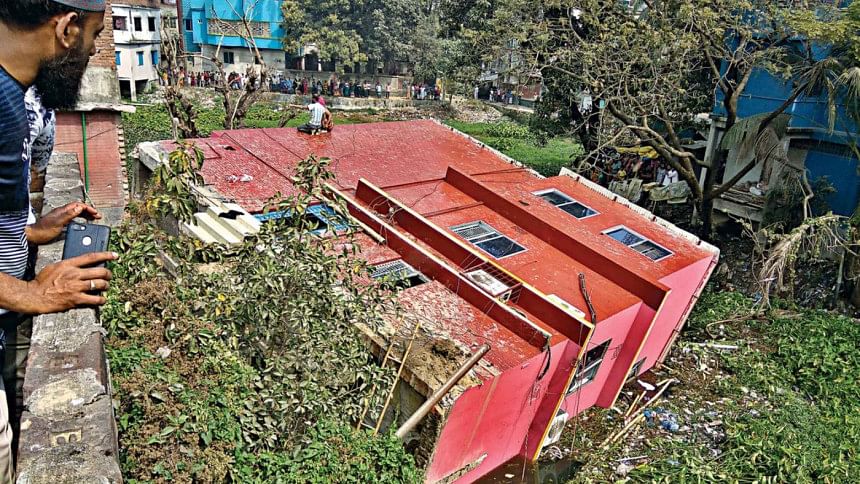Building collapse in Keraniganj

Frequent incidents of building collapse in Dhaka have become a major cause for concern for people living in buildings that are built on water-bodies or canals. On Friday, a three-storied building in Dhaka's Keraniganj collapsed on a nearby pond, injuring seven people. According to the deputy assistant director of Fire Service and Civil Defence in Keraniganj, the building could have collapsed a long time ago because the soil it was built on was weak. Basically, a pond was filled up to construct the building without any permission from the authorities. Luckily, no lives were lost in the incident.
As more and more unauthorised buildings are being built on filled-up water-bodies and canals inside the capital and on the outskirts of the city, posing serious risk to people's lives and properties, the authorities responsible are just not doing enough to stop such illegal practices. Rajuk, being the authority that is supposed to ensure buildings comply with the building codes, has to shoulder the responsibility for what happened in Keraniganj.
The incapacity and inefficiency of Rajuk to ensure building safety have been exposed in various incidents of building fires and collapses over the years. The collapse of Rana Plaza, which killed over 1,100 people in 2013, is a glaring example of the failure of Rajuk to prevent building owners from violating the building codes. The FR Tower fire in the city's Banani in 2019 was another example of Rajuk's inefficiency to carry out its responsibility.
In 2018, Rajuk conducted a survey to find out which buildings that were built violating the building codes and found that around 1.31 lakh completed buildings out of some 1.95 lakh did not comply with the code. After the Banani fire, it conducted another survey to identify buildings flouting the building codes. Unfortunately, we do not know of any steps being taken against the violators so far. Compared to the incidents of Rana Plaza collapse and FR Tower fire, the building collapse in Keraniganj might seem very insignificant. But, if Rajuk cannot check such small-scale violations, how would they check the other major building code violations? Therefore, Rajuk should be made to answer for how the building in Keraniganj was built without its permission in the first place. Moreover, the local government authorities, the Department of Environment (DoE) also did not play their role to stop the construction of the building. The lack of accountability of the relevant bodies that ensure that buildings are constructed safely has led to these dangerous conditions that can lead to the loss of lives.

 For all latest news, follow The Daily Star's Google News channel.
For all latest news, follow The Daily Star's Google News channel. 



Comments